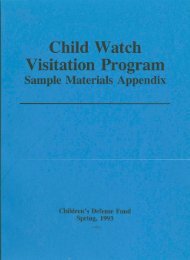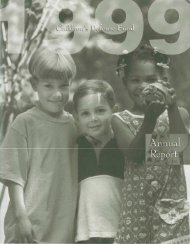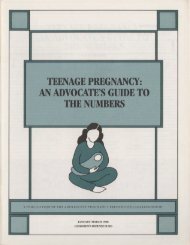children out of school in america - University of Tennessee Digital ...
children out of school in america - University of Tennessee Digital ...
children out of school in america - University of Tennessee Digital ...
Create successful ePaper yourself
Turn your PDF publications into a flip-book with our unique Google optimized e-Paper software.
•<br />
most <strong>children</strong> who are <strong>in</strong>stitutionalized are receiv<strong>in</strong>g<br />
at least some tra<strong>in</strong><strong>in</strong>g or <strong>school</strong><strong>in</strong>g (whether or not<br />
it meets the Census def<strong>in</strong>ition), we count all <strong>in</strong>stitutionalized<br />
<strong>children</strong> as enrolled. Yet we know that<br />
<strong>in</strong>stitutional <strong>school</strong><strong>in</strong>g is <strong>of</strong>ten woefully <strong>in</strong>adequate<br />
and that some <strong>in</strong>stitutions provide no educational<br />
programs. 7 We have estimated the number assumed<br />
to be <strong>in</strong>stitutionalized, but not enrolled, for each<br />
state and have reduced the number not enrolled by<br />
this amount.<br />
Therefore, we added, for the 5-13 age group, the<br />
males and females <strong>in</strong> the three categories <strong>of</strong> <strong>in</strong>stitutions,<br />
and took 7/9ths <strong>of</strong> this figure to account for<br />
ages 5 and 6. The 14 and 15 year olds were totaled<br />
and added to the 7-13 group. We then took 39 percentS<br />
<strong>of</strong> the 7-15 total <strong>in</strong>stitutionalized to estimate<br />
the number <strong>in</strong>stitutionalized but not enrolled. This<br />
procedure was then repeated for 16 and 17 year olds<br />
us<strong>in</strong>g 45.6 percent and for 6 years olds <strong>in</strong> target<br />
area states us<strong>in</strong>g 58.7 percent. Next, the <strong>in</strong>stitutional<br />
not enrolled were deducted from the total not enrolled<br />
to determ<strong>in</strong>e the number "Not Enrolled (Adjusted)."<br />
F<strong>in</strong>ally, totals for ages 7-17 were computed<br />
for each state.<br />
White and Nonwhite<br />
Procedure. Table 146 is given for the state by<br />
racial breakdown. We calculated the white <strong>children</strong><br />
<strong>in</strong> and <strong>out</strong> <strong>of</strong> <strong>school</strong>, and subtracted them from the<br />
total to give the nonwhite figures. The <strong>in</strong>stitutional<br />
adjustment was computed from data <strong>in</strong> Table 154<br />
as it was for total population.<br />
Urban and Rural<br />
Procedure. Data are given for three types <strong>of</strong><br />
7 In 1970 the School <strong>of</strong> Social Service Adm<strong>in</strong>istration at the<br />
the <strong>University</strong> <strong>of</strong> Chicago published a study <strong>of</strong> <strong>children</strong> <strong>in</strong><br />
residential <strong>in</strong>stitutions which showed that over 7 percent <strong>of</strong><br />
the 2,318 <strong>in</strong>stitutions surveyed <strong>in</strong> 1966 had no <strong>children</strong> attend<strong>in</strong>g<br />
<strong>school</strong>, and that <strong>of</strong> the <strong>in</strong>stitutions which provided<br />
<strong>school</strong>s facilities on their grounds, 20 percent did not<br />
provide services for all grade levels atta<strong>in</strong>ed by the <strong>children</strong><br />
<strong>in</strong> residence. 30.4 percent <strong>of</strong> the <strong>in</strong>stitutions surveyed<br />
reported that they wanted to expand or develop formal<br />
<strong>school</strong> facilities on their grounds, and over 50 percent <strong>of</strong><br />
the <strong>in</strong>stitutions <strong>in</strong>dicated that they wanted to expand or<br />
develop tutor<strong>in</strong>g, remedial or other <strong>in</strong>dividualized educational<br />
programs.<br />
S The U.S. percent <strong>of</strong> <strong>in</strong>mates <strong>of</strong> <strong>in</strong>stitutions not enrolled<br />
<strong>in</strong> <strong>school</strong>; 1970 Census <strong>of</strong> Population, Persons <strong>in</strong> Institutions<br />
and Other Group Quarters, P.C. (2)-4E, Table 20.<br />
154<br />
places: urban, rural farm and rural non-farm. Although<br />
racial breakdowns are given with<strong>in</strong> each type<br />
<strong>of</strong> place, we did not make calculations by race with<strong>in</strong><br />
urban or rural areas, nor separate rural <strong>in</strong>to farm<br />
and non-farm. We calculated the number <strong>of</strong> <strong>children</strong><br />
<strong>in</strong> and <strong>out</strong> <strong>of</strong> <strong>school</strong> for urban areas, and subtracted<br />
these figures from the totals.<br />
Urban-rural <strong>in</strong>stitutional data were only given for<br />
age group<strong>in</strong>gs "under 14 years" (rather than for "5<br />
to 13" as it was for the total population), "14 and<br />
15 years," and "16 and 17 years." We had no actual<br />
data for determ<strong>in</strong><strong>in</strong>g the percentage <strong>of</strong> the total<br />
population <strong>in</strong>stitutionalized for ages 7 to 13. Because<br />
it was expected that <strong>in</strong>stitutionalization would<br />
vary from the average dur<strong>in</strong>g the early years, an<br />
alternative means <strong>of</strong> estimat<strong>in</strong>g the urban <strong>in</strong>stitutionalized<br />
was used. That is, <strong>children</strong> <strong>in</strong> <strong>in</strong>stitutions<br />
were allocated between urban and rural on the basis<br />
<strong>of</strong> the ratio <strong>of</strong> urban and rural <strong>in</strong> the total population<br />
for that age group. This will reduce the reliability<br />
<strong>of</strong> the estimate.<br />
Children Not Enrolled By Regions<br />
(Chapter 2, Tables I, III and IV)<br />
State data for Tables I, III and IV were rearranged<br />
and summarized by regions from standard Census<br />
regional designations.<br />
Children Not Enrolled, By Education and Income<br />
<strong>of</strong> Parent (Chapter 2, Table V)<br />
Source. School Enrollment Supplement, Table 8<br />
-Enrollment Status and Relative Progress <strong>in</strong> School<br />
<strong>of</strong> Persons 3 to 17 Years Old Liv<strong>in</strong>g With One or<br />
Both Parents by Education <strong>of</strong> Parent, Family Income,<br />
Control <strong>of</strong> School, Age on October 1, 1969,<br />
Race, Spanish Language, and Sex: 1970.<br />
Procedure. Data are given by year for ages 3 to<br />
7, as an age group<strong>in</strong>g for 8 to 15 year olds, and<br />
separately for male and female 16 and 17 year olds.<br />
Population and enrollment data are given for each<br />
age group by education <strong>of</strong> parent and family <strong>in</strong>come<br />
as follows:<br />
-Less than 8 years <strong>of</strong> <strong>school</strong>: Under $4,000;<br />
$4,000 to 9,999; $10,000 or more.<br />
-8 to 11 years <strong>of</strong> <strong>school</strong>: Under $4,000; $4,999<br />
to 6,999; $7,000 to 9,999; $10,000 or more.<br />
-12 years <strong>of</strong> <strong>school</strong>: Under $4,000; $4,000 to<br />
6,999; $7,000 to 9,999; $10,000 or more.














